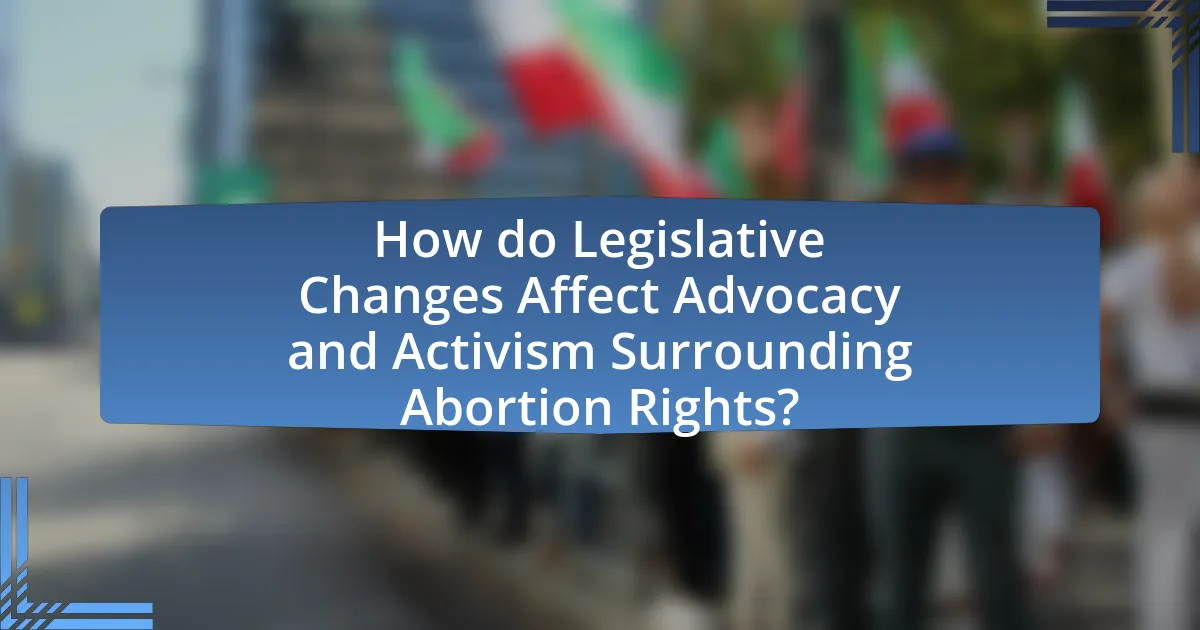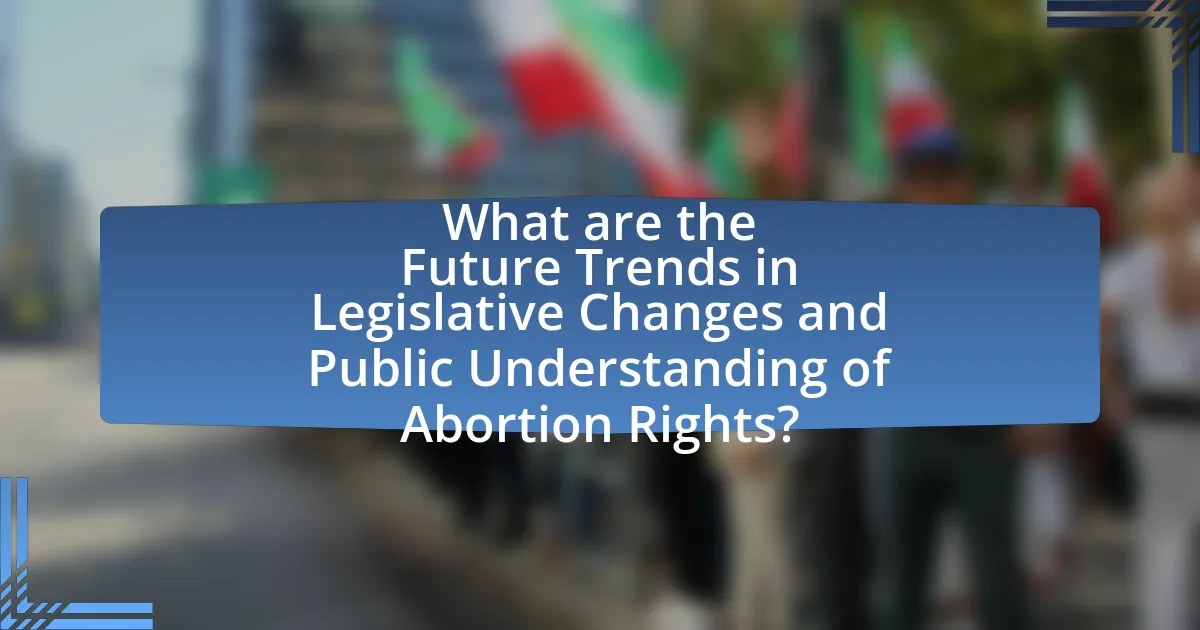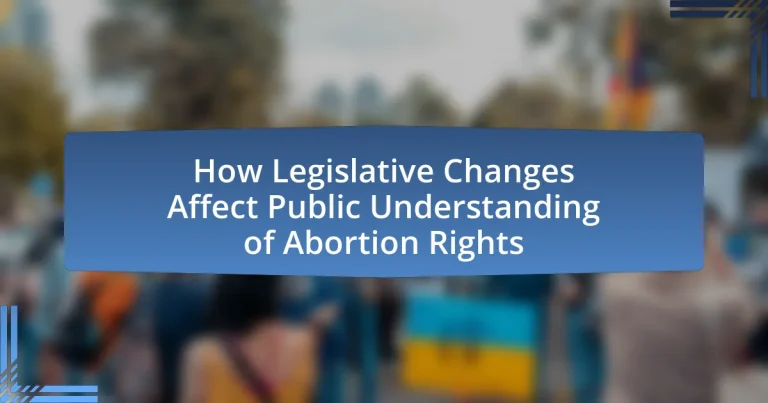The article examines how legislative changes impact public understanding of abortion rights, highlighting the correlation between legal frameworks and societal perceptions. It discusses key legislative milestones, such as the overturning of Roe v. Wade, and their effects on public opinion, activism, and demographic responses. The article also explores the role of media in shaping discourse, the challenges faced by advocacy groups, and the importance of public education initiatives in addressing misconceptions. Additionally, it outlines future trends in legislation and public sentiment, emphasizing the ongoing influence of legal changes on reproductive rights discussions.

How do Legislative Changes Influence Public Perception of Abortion Rights?
Legislative changes significantly influence public perception of abortion rights by shaping the legal framework and societal norms surrounding the issue. For instance, when states enact restrictive abortion laws, public opinion often shifts towards viewing abortion as a more contentious and polarized issue. Research from the Guttmacher Institute indicates that after the implementation of laws limiting access to abortion, there is typically an increase in public discourse and activism, which can lead to heightened awareness and division among different demographic groups. Additionally, surveys conducted by Pew Research Center show that legislative actions, such as the overturning of Roe v. Wade, have resulted in a marked increase in the number of individuals identifying as pro-choice or pro-life, reflecting a direct correlation between legal changes and public sentiment.
What are the key legislative changes impacting abortion rights?
Key legislative changes impacting abortion rights include the overturning of Roe v. Wade by the U.S. Supreme Court in June 2022, which ended federal protections for abortion access and allowed states to set their own laws. Following this decision, numerous states enacted restrictive laws, with some implementing near-total bans on abortion, while others expanded access. For instance, states like Texas and Alabama passed laws that significantly limit abortion procedures, whereas states like California and New York have enacted measures to protect and expand abortion rights. These changes reflect a significant shift in the legal landscape surrounding abortion, influencing public understanding and access to reproductive healthcare.
How have recent laws altered the landscape of abortion rights?
Recent laws have significantly restricted abortion rights in various states, particularly following the Supreme Court’s decision in Dobbs v. Jackson Women’s Health Organization in 2022, which overturned Roe v. Wade. This ruling allowed states to implement stricter abortion regulations, leading to a wave of legislation that bans or severely limits access to abortion services in many regions. For instance, as of 2023, over 20 states have enacted laws that either ban abortions outright or impose stringent gestational limits, reflecting a dramatic shift in the legal landscape surrounding reproductive rights. These changes have not only affected access to abortion but have also influenced public perception and understanding of reproductive health issues, as communities grapple with the implications of these new laws.
What historical legislative changes have shaped current public understanding?
The historical legislative changes that have shaped current public understanding of abortion rights include the Roe v. Wade decision in 1973, which established a woman’s legal right to choose an abortion, and the subsequent legislative actions such as the Partial-Birth Abortion Ban Act of 2003. Roe v. Wade provided a constitutional framework that influenced public perception by framing abortion as a matter of personal choice and privacy. The Partial-Birth Abortion Ban Act, on the other hand, reflected a shift towards more restrictive measures, impacting public discourse by emphasizing moral and ethical considerations surrounding late-term abortions. These legislative milestones have significantly influenced societal attitudes and the ongoing debate regarding abortion rights in the United States.
Why is public understanding of abortion rights important?
Public understanding of abortion rights is crucial because it influences legislative outcomes and societal attitudes towards reproductive health. When the public is informed about abortion rights, it fosters advocacy for policies that protect these rights, as evidenced by the increased support for reproductive rights in states with comprehensive sex education and access to healthcare services. Furthermore, studies show that informed communities are more likely to engage in discussions and activism, which can lead to more equitable laws and protections for individuals seeking abortion services.
How does public perception affect policy-making on abortion?
Public perception significantly influences policy-making on abortion by shaping lawmakers’ decisions based on constituents’ views. When a majority of the public supports or opposes abortion rights, elected officials often align their policies with these sentiments to secure votes and maintain political support. For instance, surveys indicate that in the United States, public opinion has shifted towards supporting abortion rights, which has led to legislative changes in various states that protect access to abortion services. Additionally, high-profile cases and media coverage can amplify public sentiment, prompting policymakers to respond swiftly to perceived public demands. This dynamic illustrates the direct correlation between public perception and legislative action regarding abortion rights.
What role does media play in shaping public understanding of abortion rights?
Media plays a crucial role in shaping public understanding of abortion rights by influencing perceptions, framing debates, and disseminating information. Through various platforms, including news outlets, social media, and documentaries, media coverage can highlight personal stories, expert opinions, and statistical data, which collectively inform public attitudes. For instance, studies have shown that increased media attention on abortion-related issues correlates with heightened public awareness and shifts in opinion, as seen during significant legislative changes like the 1973 Roe v. Wade decision and more recent state-level restrictions. This demonstrates that media not only reflects societal views but actively participates in the discourse surrounding abortion rights, impacting how individuals understand and engage with the topic.
What are the implications of legislative changes on public discourse about abortion?
Legislative changes significantly shape public discourse about abortion by influencing societal attitudes and perceptions. For instance, when laws are enacted that restrict access to abortion services, public conversations often shift towards debates on women’s rights, healthcare access, and moral considerations surrounding the issue. Research indicates that states with more restrictive abortion laws experience heightened public engagement and polarization on the topic, as seen in the aftermath of the 2022 Supreme Court decision in Dobbs v. Jackson Women’s Health Organization, which overturned Roe v. Wade. This ruling led to increased activism and public demonstrations, reflecting a surge in discourse surrounding reproductive rights and personal autonomy. Consequently, legislative changes not only alter the legal landscape but also catalyze broader societal discussions, often resulting in a more divided public opinion on abortion.
How do different demographics respond to changes in abortion legislation?
Different demographics respond to changes in abortion legislation in varied ways, influenced by factors such as age, gender, race, and socio-economic status. For instance, younger individuals, particularly those aged 18-29, tend to support abortion rights more strongly than older generations, with 70% of this age group favoring legal access according to a 2021 Pew Research Center survey. Women generally advocate for reproductive rights more than men, with 61% of women supporting legal abortion compared to 50% of men, as reported by the Guttmacher Institute. Racial and ethnic differences also play a role; Black and Hispanic communities often express higher support for abortion rights compared to white populations, reflecting diverse cultural and religious influences. Additionally, socio-economic factors impact perspectives, with lower-income individuals more likely to view abortion access as essential for economic stability. These demographic variations highlight the complexity of public opinion on abortion legislation and its implications for policy-making.
What are the common misconceptions about abortion rights following legislative changes?
Common misconceptions about abortion rights following legislative changes include the belief that such changes universally restrict access to abortion, that all states have the same laws, and that legislative changes reflect a uniform public opinion. In reality, while some states have enacted stricter laws, others have expanded access, leading to a patchwork of regulations across the country. For instance, after the Supreme Court’s decision in 2022 to overturn Roe v. Wade, states like California and New York moved to protect and expand abortion rights, contrasting with states like Texas that implemented stringent restrictions. This demonstrates that legislative changes do not uniformly affect abortion rights and that public opinion varies significantly by region.

How do Legislative Changes Affect Advocacy and Activism Surrounding Abortion Rights?
Legislative changes significantly impact advocacy and activism surrounding abortion rights by altering the legal landscape and influencing public perception. For instance, when restrictive laws are enacted, advocacy groups often mobilize to challenge these regulations, leading to increased activism, public demonstrations, and legal battles. A notable example is the wave of protests following the 2019 passage of restrictive abortion laws in several U.S. states, which galvanized national attention and support for reproductive rights. Conversely, when laws expand access to abortion, advocacy efforts may shift towards protecting those rights and ensuring they are upheld, as seen after the 1973 Roe v. Wade decision, which sparked a surge in pro-choice activism. These legislative shifts directly shape the strategies and focus of advocacy organizations, as they respond to the changing legal context and public sentiment regarding abortion rights.
What strategies do advocacy groups employ in response to legislative changes?
Advocacy groups employ several strategies in response to legislative changes, including mobilizing grassroots campaigns, engaging in lobbying efforts, and utilizing media outreach. Grassroots campaigns involve organizing community members to raise awareness and influence public opinion, often through protests or petitions. Lobbying efforts focus on directly interacting with lawmakers to advocate for specific policies or amendments, leveraging data and personal stories to highlight the impact of legislative changes. Media outreach encompasses crafting press releases, utilizing social media platforms, and engaging with journalists to disseminate information and shape narratives around abortion rights, thereby informing and educating the public about the implications of new laws. These strategies are essential for advocacy groups to effectively respond to and influence the legislative landscape surrounding abortion rights.
How do advocacy efforts shift based on new laws?
Advocacy efforts shift significantly based on new laws, as organizations adapt their strategies to align with the legal landscape. For instance, when laws become more restrictive, advocacy groups often intensify their campaigns to mobilize public opinion against such changes, utilizing data and personal stories to highlight the negative impacts on individuals’ rights. Conversely, when laws expand access to abortion rights, advocacy efforts may focus on education and outreach to inform the public about new options available, as seen in states that have recently enacted protective legislation. This dynamic response is evidenced by the increased funding and resources allocated to grassroots movements following the enactment of restrictive laws in various states, demonstrating a direct correlation between legislative changes and advocacy strategies.
What are the challenges faced by activists in changing political climates?
Activists face significant challenges in changing political climates, including increased governmental repression, shifting public opinion, and resource limitations. Governmental repression can manifest through restrictive laws, surveillance, and criminalization of protests, which hinder activists’ ability to organize and advocate effectively. Shifting public opinion complicates the messaging and strategies activists must employ, as they must navigate a landscape where societal attitudes can rapidly change, often influenced by media narratives and political rhetoric. Additionally, resource limitations, such as funding and volunteer support, can restrict the capacity of activist organizations to mobilize and sustain their efforts, particularly in politically hostile environments. These challenges are evident in various movements, such as those advocating for abortion rights, where activists must continuously adapt to legislative changes and public sentiment to maintain momentum and achieve their goals.
How do legislative changes mobilize public support or opposition?
Legislative changes mobilize public support or opposition by directly influencing public perception and engagement regarding specific issues. For instance, when laws are enacted that expand or restrict abortion rights, they often provoke strong emotional responses, leading to organized advocacy or protest efforts. Research indicates that significant legislative shifts, such as the 1973 Roe v. Wade decision, galvanized both pro-choice and pro-life movements, resulting in increased activism and public discourse surrounding abortion rights. This mobilization is further supported by media coverage, which amplifies the visibility of these changes and shapes public opinion, as seen in the aftermath of the 2022 Dobbs v. Jackson Women’s Health Organization ruling, which led to widespread protests and advocacy campaigns across the United States.
What events or campaigns have been influenced by recent legislative changes?
Recent legislative changes have significantly influenced events and campaigns surrounding abortion rights, notably the Women’s March and various state-level advocacy initiatives. For instance, following the overturning of Roe v. Wade in 2022, numerous states enacted restrictive abortion laws, prompting widespread protests and mobilization efforts, such as the Women’s March on Washington, which drew hundreds of thousands advocating for reproductive rights. Additionally, organizations like Planned Parenthood have launched campaigns to educate the public on the implications of these legislative changes, emphasizing the need for continued advocacy and support for reproductive health access. These events and campaigns reflect a direct response to the evolving legal landscape regarding abortion rights in the United States.
How do grassroots movements adapt to new legal frameworks?
Grassroots movements adapt to new legal frameworks by re-evaluating their strategies, mobilizing community support, and leveraging legal advocacy. When laws change, these movements often assess the implications of the new regulations on their objectives, which allows them to realign their campaigns accordingly. For instance, after the introduction of restrictive abortion laws in various states, grassroots organizations have shifted focus to educational outreach and legal challenges, aiming to inform the public about their rights and the implications of these laws. This adaptability is evidenced by the increased collaboration between grassroots groups and legal experts, which enhances their capacity to navigate the complexities of new legal landscapes effectively.

What are the Future Trends in Legislative Changes and Public Understanding of Abortion Rights?
Future trends in legislative changes regarding abortion rights indicate a potential increase in state-level restrictions and a growing polarization in public understanding. Recent data shows that since the Supreme Court’s decision in 2022 to overturn Roe v. Wade, numerous states have enacted stricter abortion laws, reflecting a trend toward more conservative policies. For instance, as of 2023, over 20 states have implemented significant restrictions or outright bans on abortion, which has led to heightened public discourse and activism surrounding reproductive rights.
Public understanding is also evolving, with surveys indicating that opinions on abortion are increasingly divided along political lines. A 2023 Gallup poll revealed that 55% of Americans identify as pro-choice, yet this figure masks deeper divisions, as support varies significantly by demographic factors such as age, race, and political affiliation. This polarization suggests that legislative changes will continue to shape public perceptions, leading to more organized advocacy efforts on both sides of the debate.
Overall, the interplay between legislative actions and public sentiment is likely to intensify, influencing future discussions and policies related to abortion rights.
How might upcoming legislation further impact public understanding of abortion rights?
Upcoming legislation may significantly shape public understanding of abortion rights by clarifying legal frameworks and influencing societal attitudes. For instance, laws that expand access to abortion services can enhance awareness of reproductive rights, while restrictive laws may provoke public debate and mobilization around the issue. Historical data shows that legislative changes often correlate with shifts in public opinion; for example, the 1973 Roe v. Wade decision led to increased public discourse and awareness regarding abortion rights. Thus, the nature of upcoming legislation will likely determine whether public understanding becomes more informed or polarized.
What potential changes are on the horizon for abortion legislation?
Potential changes on the horizon for abortion legislation include increased state-level restrictions and potential federal legislative actions aimed at protecting or limiting access to abortion services. Following the Supreme Court’s decision in Dobbs v. Jackson Women’s Health Organization in 2022, which overturned Roe v. Wade, many states have enacted stricter abortion laws, while others are considering measures to safeguard abortion rights. For instance, states like California and New York are advancing laws to protect access, while states such as Texas and Florida have implemented significant restrictions. These developments indicate a polarized landscape where legislative changes are likely to continue influencing public understanding and access to abortion rights.
How can public education initiatives address misconceptions about abortion rights?
Public education initiatives can address misconceptions about abortion rights by providing accurate information and fostering open dialogue. These initiatives can include comprehensive sex education programs that cover reproductive health, legal rights, and the implications of legislative changes on access to abortion. For instance, studies show that states with comprehensive sex education have lower rates of unintended pregnancies and higher rates of contraceptive use, which can lead to a better understanding of abortion rights. Additionally, campaigns that utilize social media and community outreach can dispel myths and clarify legal frameworks surrounding abortion, thereby enhancing public knowledge and reducing stigma.
What best practices can be adopted to enhance public understanding of abortion rights?
To enhance public understanding of abortion rights, educational initiatives that provide accurate, evidence-based information are essential. These initiatives can include comprehensive sex education programs that cover reproductive health, legal rights, and the implications of legislative changes. Research indicates that states with comprehensive sex education have lower rates of unintended pregnancies and higher rates of contraceptive use, which underscores the importance of informed decision-making. Additionally, community outreach programs that engage diverse populations through workshops, discussions, and accessible resources can foster dialogue and dispel myths surrounding abortion. Studies show that personal narratives and testimonials can significantly impact public perception, making it crucial to include voices from individuals with lived experiences. Furthermore, collaboration with healthcare providers to disseminate clear information about abortion services and rights can empower individuals to make informed choices.
How can stakeholders effectively communicate changes in abortion legislation?
Stakeholders can effectively communicate changes in abortion legislation by utilizing clear, consistent messaging through multiple channels, including social media, press releases, and community outreach. This approach ensures that accurate information reaches diverse audiences, addressing potential misinformation and fostering public understanding. For instance, organizations like Planned Parenthood have successfully employed targeted campaigns to inform the public about legislative changes, utilizing data-driven strategies to highlight the implications of new laws on reproductive rights. Such methods not only disseminate information but also engage stakeholders in dialogue, enhancing transparency and trust in the legislative process.
What role can educational institutions play in shaping informed public discourse on abortion rights?
Educational institutions play a crucial role in shaping informed public discourse on abortion rights by providing comprehensive education on reproductive health, legal frameworks, and ethical considerations. Through curricula that include discussions on the history of abortion laws, the implications of legislative changes, and the socio-economic factors influencing access to abortion, these institutions equip students with the knowledge necessary to engage in informed debates. For instance, research from the Guttmacher Institute indicates that comprehensive sex education can lead to more informed attitudes towards reproductive rights, highlighting the importance of educational frameworks in fostering understanding. By facilitating critical thinking and encouraging open dialogue, educational institutions can significantly influence public perceptions and discussions surrounding abortion rights.


